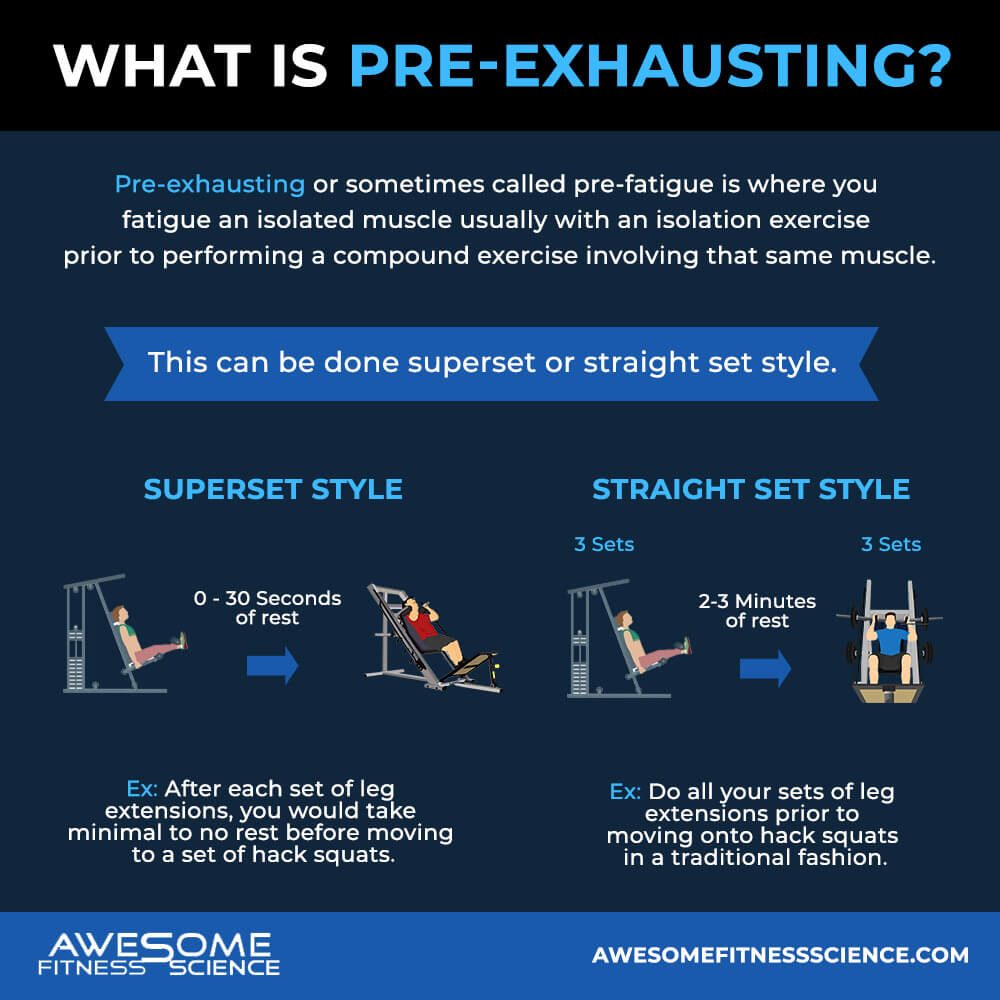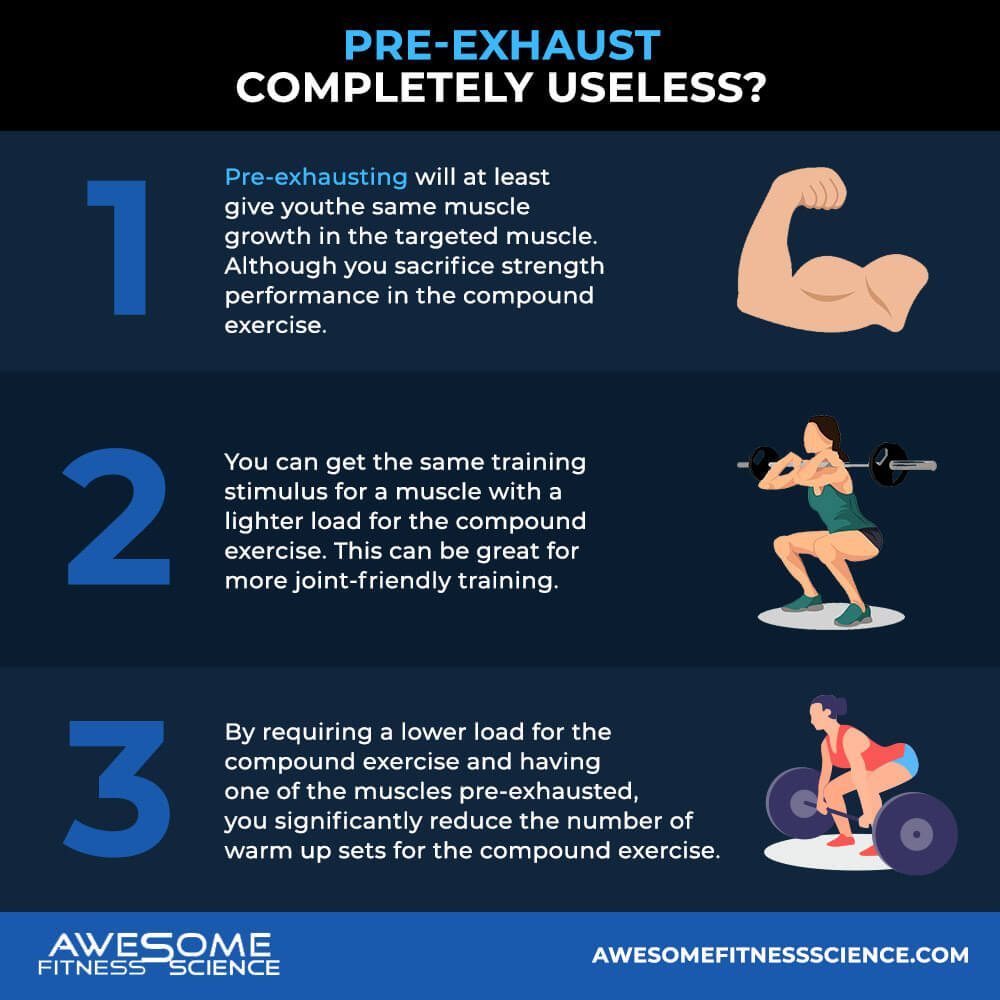
Low Carb Vs Low Fat – Dissecting the Diets
Many people approach weight loss by going low carb because they believe carbs are the evil culprit for storing unwanted blubber around their waist.

Pre-exhausting is an interesting muscle building technique that’s gaining much popularity. But if you’ve been following me long enough, you know I don’t give a flying a fairy what’s popular or not.
I dissect the truth as objectively as I can, that is unless a hot girl offers me some cuddles and cookies. Partially joking of course, but anyways, I don’t think the evidence supports the technique of pre-exhausting. Pre-exhausting has it’s uses, but it reminds me of spam musubi. Kind of decent, but mostly overrated.
Let me explain.
Pre-exhausting or sometimes called pre-fatigue is where you fatigue an isolated muscle usually with an isolation exercise prior to performing a compound exercise involving that same muscle.
This can be done superset or straight set style.
With a superset style, you could do leg extensions supersetted with hack squats. So after each set of leg extensions, you would take minimal to no rest before moving to a set of hack squats.
In a straight set style, you would simply do all your sets of leg extensions prior to moving onto hack squats in a traditional fashion.
Usually, most people do pre-exhausting via supersets. The style doesn’t matter much though.
The goal of pre-exhausting is to fatigue a local muscle so when you do a compound exercise involving it, that muscle becomes the limiting factor. For example, if you did a set of bench press first, your chest is likely to limit the movement, so if failure is reached, your chest reached muscular failure, but other bench pressing muscles might not have.
If you did some triceps pushdowns prior to a set of benching though, your triceps enter the set compromised and thus, are more likely to reach higher levels of muscular fatigue giving your triceps a better stimulus for growth on the compound exercise. Well, that’s the theory at least.

However, if you’re trying to target a muscle with a compound exercise that inherently limits a different muscle, why not choose a better compound exercise in the first place? Or better yet, simply do more of the isolation exercise where you undoubtedly know the targeted muscle will receive good growth without the fatigue of a compound exercise.
So for example, if you wanted more triceps growth, instead of forcing bench pressing to be more hypertrophic for the triceps (which none of them are if you understand basic anatomy) (1), why not simply do more isolated triceps work like rope extensions?
Let’s say you do choose a solid compound and isolation exercise for a specific muscle. For example, we’ll say leg presses and leg extensions for the quads.
Even then, there’s no muscle building incentive to pre-exhaust. The quads become an even earlier limiting factor in the compound exercise, so you limit glute growth in the leg press.
So to maximize both quad and glute growth, you should be doing your leg presses first and leg extensions after (2,3).
This is because pre-exhausting limits overall strength performance. While you’ll get more performance from the isolation exercise coming first, the compound exercise which hits more muscles gets compromised (4,7).
No matter how good the pump may feel, objective research finds pre-exhausting the target muscle doesn’t increase it’s activation in the compound set (5,7). In some cases, it reduces it (6).
Pre-exhausting will at least give you the same muscle growth in the targeted muscle. Although you sacrifice strength performance in the compound exercise, this might be a good thing.
You can get the same training stimulus for a muscle with a lighter load for the compound exercise. This can be great for more joint-friendly training.
Furthermore, by requiring a lower load for the compound exercise and having one of the muscles pre-exhausted, you significantly reduce the number of warm up sets for the compound exercise.
Anything to save time can be valuable for recreational lifters.

It’s not the worse technique, but it’s shouldn’t be a default tool in a serious lifter’s arsenal as the drawbacks aren’t worth the benefits.
I know I sound like a dream crusher, but hey, if you’re new around here, get used to learning more unsexy truths about fitness instead of exciting lies.
1. Ogasawara. “Time Course for Arm and Chest Muscle Thickness Changes Following Bench Press Training.” Interventional Medicine & Applied Science, U.S. National Library of Medicine, pubmed.ncbi.nlm.nih.gov/24265879/.
2. Trindade, Thiago Barbosa, et al. “Effects of Pre-Exhaustion Versus Traditional Resistance Training on Training Volume, Maximal Strength, and Quadriceps Hypertrophy.” Frontiers, Frontiers, 4 Nov. 2019, www.frontiersin.org/articles/10.3389/fphys.2019.01424/full.
3. “What Influence Does Resistance Exercise Order Have on Muscular Strength Gains and Muscle Hypertrophy? A Systematic Review and Meta-Analysis.” Taylor & Francis, www.tandfonline.com/doi/full/10.1080/17461391.2020.1733672.
4. Ribeiro, Alex Silva, et al. “The Potential Role of Pre-Exhaustion Training in Maximizing Muscle Hypertrophy: A Review of the Literature.” ResearchGate,
5. Gentil . “Effects of Exercise Order on Upper-Body Muscle Activation and Exercise Performance.” Journal of Strength and Conditioning Research, U.S. National Library of Medicine, pubmed.ncbi.nlm.nih.gov/18076251/.
6. Augustsson . “Effect of Pre-Exhaustion Exercise on Lower-Extremity Muscle Activation during a Leg Press Exercise.” Journal of Strength and Conditioning Research, U.S. National Library of Medicine, pubmed.ncbi.nlm.nih.gov/12741886/.
7. Wallace . “Repeated Bouts of Advanced Strength Training Techniques: Effects on Volume Load, Metabolic Responses, and Muscle Activation in Trained Individuals.” Sports (Basel, Switzerland), U.S. National Library of Medicine, pubmed.ncbi.nlm.nih.gov/30621334/.
Sign up for AwesomeFitnessScience Weekly. You’ll get juicy insider secrets, updates, and stories.

Many people approach weight loss by going low carb because they believe carbs are the evil culprit for storing unwanted blubber around their waist.

Cholesterol was once thought of as a dangerous artery clogging nutrient. Fortunately, research shows cholesterol is not the enemy we once thought it was.

Refeeds are essentially mini diet breaks. However, instead of going to maintenance for weeks at a time, refeeds only last days. Some people also take refeeds into a surplus.